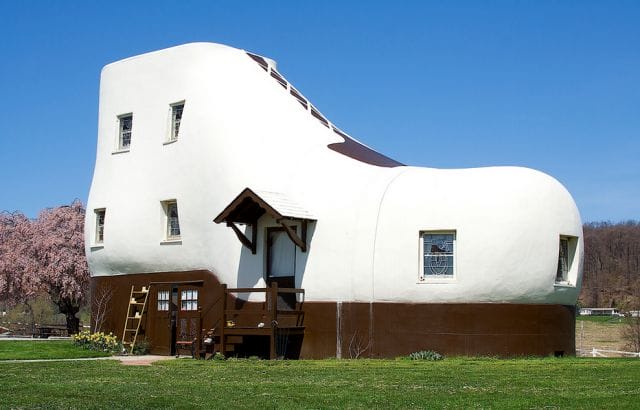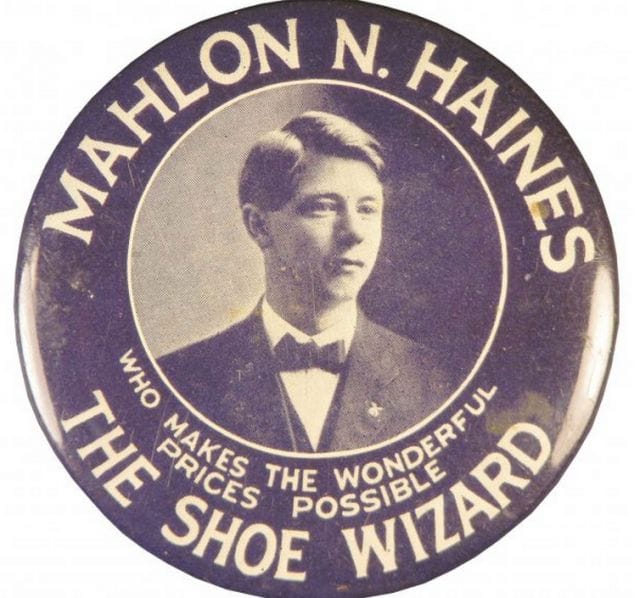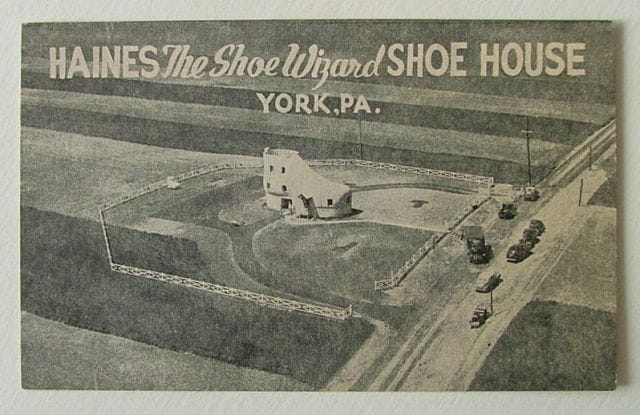
The Shoe House (York, Pennsylvania); Photo: Katrina WIlliams
In 1948, an eccentric shoe salesman from Pennsylvania approached an architect, handed the man a work boot, and said “Build me a house like this.”
The property began as nothing more than an outlandish marketing gimmick, but has since become a community staple and an homage to the generous, quirky man who conceived it.
Today, situated in a grassy knoll on the outskirts of York, the Shoe House still stands. Its history tells a unique story of innovation, compassion, and creativity.
America’s “Shoe Wizard”
At the turn of the 20th century, “Colonel” Mahlon N. Haines moved from from his birthplace in Old Washington, Ohio to York, Pennsylvania with little more than a knapsack to his name. In his early twenties, he took a job as a shoe salesman, and found he had a knack for it: his first sale netted him $127.00 (about $3,000 today).
Amidst his early success in the business, Haines taught himself how to cobble shoes, and invested his earnings in his own business. Over the next twenty years, he’d build a shoe empire that included over 40 stores across central Pennsylvania and northern Maryland. His shoes –priced at $1.98 a pair — adorned the feet of hundreds of thousands through the mid-1900s.

A young Mahlon N. Haines adorns a pin (likely another of his marketing ploys), circa 1940.
He made millions, and became known for his oft-outlandish antics and garish, flamboyant ways. In the 1930s, during the Great Depression, he’d stand up at baseball games and offer anyone who knew him $20 (nearly $300 in 2014 dollars). He developed an affinity for the Boy Scouts of America, and built “Wizard Ranch,” a sprawling property on which he staged safaris and tours for thousands of young men.
Likewise, he despised smoking so much that he would stop people on the street and offer them money to put out their cigarettes. By all accounts, the man was an eccentric philanthropist: “I came into this world with nothing,” he’d say, “and I’d like to leave the same way!”
But in 1948, Haines dreamt up his quirkiest plan yet: he’d build a fully functional house shaped like a shoe.
The Shoe House

Shoe house during construction, 1948; Lincoln Highway: Pennsylvania Traveler’s Guide
The property’s design emulated a “high-topped work shoe” Haines had handed to his architect, and was constructed using a wood frame structure, wire lath, and cement stucco. Haines conceived every last detail — from a shoe-shaped dog house, to shoe-decorated picket fences — and, after briefly living in the property, wasted no time in giving it away to the community.
Throughout 1949, Haines invited elderly couples for weekend stays in the house at his own expense. He ensured his guests were treated like “kings and queens,” employing a maid, cook, and chauffeur, and treating them to extravagant shopping sprees in town. He even purchased an automobile specifically for to use of his guests.
Subsequently, Haines offered the house (again, at no cost) to honeymooning couples “from any town with a Haines shoe store.” In a final act of charity, Haines donated the Shoe House to his employees before passing away toward the end of 1962.
Over the next forty years, the house changed hands a number of times (notably operating as an ice cream parlor throughout the 1980s) before being purchased, historically renovated, and converted to a museum (and homage to “Colonel” Haines).

An old Shoe House postcard, circa 1950; eBay.
In 2003, the property was acquired by a Carleen Farabaugh, a woman who “took her shoe fetish to an extreme.” Along with husband Ronald, Farabaugh spent $40,000 restoring the house, and continues to run tours during the summer months. The two live in the property year-round. Farabough says she’s content living in the shoe:
“I have absolutely no idea what possessed me to buy it and I don’t think I’ll ever be able to answer that question. I love the house…it’s every woman’s dream home…but it can be challenging at times because all of the rooms are obviously strange shapes.”
The house’s oddball dimensions — 25 feet tall at its peak, 48 feet in length, and 17 feet wide — make for an interesting interior. In the shoe’s toe is a low-ceiling living room, in it’s heel, a kitchen; two bedrooms are located in the ankle, and an ice cream shop is located in the instep. Also inside are two bathrooms (we hear the toilets are “shoe-inspired” as well).
“People might think I’m crazy but I don’t care.” Farabaugh adds. Her sentiment echoes that of her home’s creator: sixty-five years ago, Mahlon N. Haines likely said the same thing.
This post was written by Zachary Crockett. Follow him on Twitter here, or Google Plus here.



